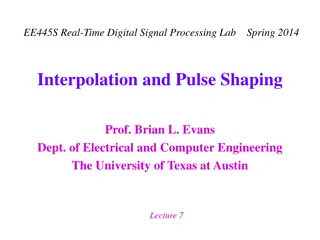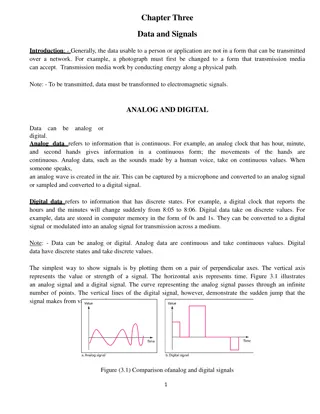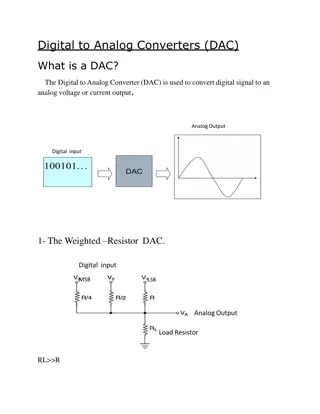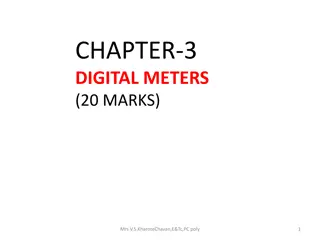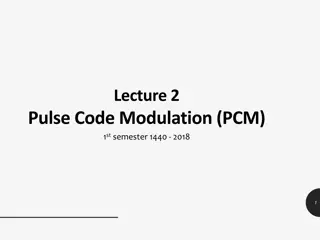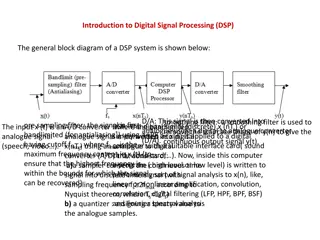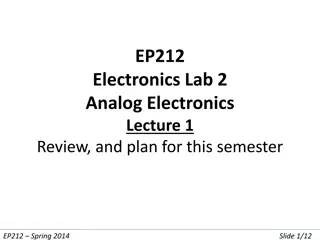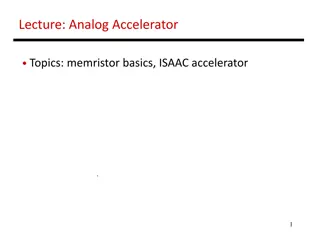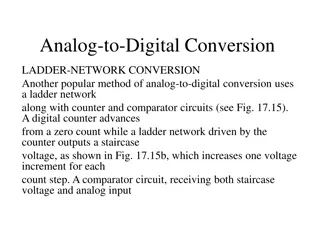ANALOG AND DIGITAL ELECTRONICS 21CS33
Explore the world of analog and digital electronics through the lens of registers, counters, and flip-flops. Dive deep into the operation of these components, learn how to transfer data between registers, build and analyze shift registers, construct timing diagrams, and understand binary counters. Discover the fundamentals of sequential circuits, state graphs, and more with practical applications and insights.
Download Presentation

Please find below an Image/Link to download the presentation.
The content on the website is provided AS IS for your information and personal use only. It may not be sold, licensed, or shared on other websites without obtaining consent from the author.If you encounter any issues during the download, it is possible that the publisher has removed the file from their server.
You are allowed to download the files provided on this website for personal or commercial use, subject to the condition that they are used lawfully. All files are the property of their respective owners.
The content on the website is provided AS IS for your information and personal use only. It may not be sold, licensed, or shared on other websites without obtaining consent from the author.
E N D
Presentation Transcript
1 ANALOG AND DIGITAL ELECTRONICS 21CS33
2 MODULE-5 Registers and Counters
3 Books Referred/Source Charles H Roth and Larry L Kinney, Analog and Digital Electronics, Cengage Learning,2019 Charles H Roth and Larry L Kinney, Fundamental of Logic Design, Cengage Learning, 2017. Donald P Leach, Albert Paul Malvino & Goutam Saha: Digital Principles and Applications, 7thEdition, Tata McGraw Hill, 2015 Anil K. Maini: Digital Electronics Applications, 2007, John Wiley & Sons, Ltd. Thomas L. Floyd: Digital Fundamentals, 9th Edition., Pearson International Edition. M. Morris Mano, Michael D. Ciletti : Digital Design With an Introduction to the Verilog HDL, 5thEdition, Pearson Education, Inc. Ronald J. Tocci, Neal S. Widmer, Gregory L. Moss: Digital systems : principles and applications 10th International Principles, Devices and Edition, Pearson Education
4 Objectives Explain the operation of registers. Show how to transfer data between registers using a tri-state bus. Explain the operation of shift registers, show how to build them using flip-flops, and analyze their operation. Construct a timing diagram for a shift register. Explain the operation of binary counters, show how to build them using flip-flops and gates, and analyze their operation. Given the present state and desired next state of a flip-flop, determine the required flip-flop inputs. Given the desired counting sequence for a counter. Construct a timing diagram for a counter by tracing signals through the circuit. Given a sequential circuit, write the next-state equations for the flip-flops and derive the state graph or state table. Using the state graph, determine the state sequence and output sequence for a given input sequence. Explain the difference between a Mealy machine and a Moore machine. Given a state table, construct the corresponding state graph, and conversely. Analyze a sequential circuit by signal tracing.
5 Introduction Each flip-flop can store one bit of information A register consists of a group of flip-flops with a common clock input. Registers are commonly used to store and shift binary data. Counters are another simple type of sequential circuit. A counter is usually constructed from two or more flip-flops which change states in a prescribed sequence when input pulses are received.
6 Registers and Register Transfers 4-Bit D Flip-Flop Registers with Data, Load, Clear, and Clock Inputs When Load = 0, the register is not clocked, and it holds its present value When Load = 1, the clock signal (Clk) is transmitted to the flip-flop clock inputs and the data applied to the D inputs will be loaded into the flip-flops on the falling edge of the clock.
7 Registers and Register Transfers 4-Bit D Flip-Flop Registers with Data, Load, Clear, and Clock Inputs If the Q outputs are 0000 (Q3 = Q2 = Q1 = Q0 = 0) and the data inputs are 1101 (D3 = 1, D2 = 1, D1 = 0 and D0 = 1), after the falling edge of the clock Q will change from 0000 to 1101 as indicated.
8 Registers and Register Transfers If flip-flops with clock enable are available When Load = 0, the clock is disabled and the register holds its data. When Load is 1, the clock is enabled, and the data applied to the D inputs will be loaded into the flip-flops, following the falling edge of the clock
9 Registers and Register Transfers A symbol for the 4-bit register using bus notation for the D inputs and Q outputs.
10 Registers and Register Transfers Data Transfer Between Registers Figure shows how data can be transferred from the output of one of two registers into a third register using tri-state buffers.
11 Registers and Register Transfers Data Transfer Between Registers If En = 1 and Load = 1, the output of register A is enabled onto the tri-state bus and the data in register A will be stored in Q after the rising edge of the clock. If En = 0 and Load = 1, the output of register B will be enabled onto the tri-state bus and stored in Q after the rising edge of the clock.
12 Registers and Register Transfers Logic Diagram for 8-Bit Register with Tri-State Output Figure (a) shows an integrated circuit register that contains eight D flip-flops with tri-state buffers at the flip-flop outputs. These buffers are enabled when En = 0. A symbol for this 8-bit register is shown in Figure (b).
13 Registers and Register Transfers Data Transfer Using a Tri-State Bus Figure shows how data can be transferred from one of four 8-bit registers into one of two other registers. 8 bits of data are transferred in parallel from register A, B, C, or D to register G or H or both.
14 Registers and Register Transfers Data Transfer Using a Tri-State Bus The operation as follows: If EF = 00, Ais stored in G (or H). If EF = 01, B is stored in G (or H). If EF = 10, C is stored in G (or H). If EF = 11, D is stored in G (or H). If LdG = 1, these signals on the bus are loaded into register G after the rising clock edge or into register H if LdH = 1.
15 Parallel Adder with Accumulator In computer circuits, it is frequently desirable to store one number in a register of flip-flops (called an accumulator) and add a second number to it, leaving the result stored in the accumulator. To build a parallel adder with an accumulator is to add a register to the full adder (FA).
16 Parallel Adder with Accumulator n-Bit Parallel Adder with Accumulator X = xn . . . x2x1 is stored in the accumulator Y= yn . . . y2 y1 is applied to the full adder inputs, The sum of X and Y appears at the adder outputs Add signal (Ad) is used to load the adder outputs into the accumulator flip- flops on the rising clock edge
17 Parallel Adder with Accumulator Before addition can take place, the accumulator must be loaded with X. This can be accomplished in two ways: Clear the accumulator Add multiplexers at the accumulator inputs Clear the accumulator using the asynchronous clear inputs on the flip-flops, and then put the X data on the Y inputs to the adder and add to the accumulator in the normal way.
18 Parallel Adder with Accumulator Add multiplexers at the accumulator inputs: So that we could select either the Y input data or the adder output to load into the accumulator.
19 Shift Registers A shift register is a register in which binary data can be stored, and this data can be shifted to the left or right when a shift signal is applied. Bits shifted out one end of the register may be lost, or if the shift register is of cyclic type, bits shifted out one end are shifted back in the other end.
20 Shift Registers TYPES OF REGISTERS
21 Shift Registers Right-Shift Register When Shift =1, the clock is enabled and shifting occurs on the rising clock edge. Shift = 0, no shifting and No changed in flip flop. The serial input (SI) is loaded into the first flip-flop (Q3) by the rising edge of the clock. At the same time, the output of the first flip-flop is loaded into the second flip- flop, the output of the second flip-flop is loaded into the third flip-flop, and the output of the third flip-flop is loaded into the last flip-flop
22 Shift Registers Right-Shift Register Shift register initially contains 0101. The serial input (SI) sequence is 1, 1, 0, 1. The sequence of shift register states is 0101, 1010, 1101, 0110, 1011.
23 Shift Registers Example: Show how a number 0100 is entered serially in a 4-bit shift register using D flip-flop. Also write state table.
24 Shift Registers Example: Suppose that it has the 4-bit number QRST = 1010 stored in it so draw the waveform Clk Serial In Q R S T 0 1 1 0 0 0 A 0 0 0 1 1 0 B 0 1 0 0 0 0 1 C 0 0 D 0 0 0 0
25 Shift Registers Cyclic Shift Register If we connect the serial output to the serial input, as shown by the dashed line, the resulting cyclic shift register performs an end-around shift. If the initial contents of the register is 0111, after one clock cycle the contents is 1011. After a second pulse, the state is 1101, then 1110, and the fourth pulse returns the register to the initial 0111 state.
26 Shift Registers 8-Bit Serial-In, Serial-Out Shift Register
27 Shift Registers 8-Bit Serial-In, Serial-Out Shift Register Serial in means that data is shifted into the first flip-flop one bit at a time, and the flip-flops cannot be loaded in parallel. Serial out means that data can only be read out of the last flip-flop
28 Shift Registers 4-bit parallel-in, parallel-out shift register
29 Shift Registers Shift register implemented using MUXes and D flip- flops (Universal shift register)
30 Shift Registers Shift register implemented using MUXes and D flip- flops
31 Shift Registers The next-state equations for the flip-flops are Q3+ = Sh L Q3 + Sh L D3 + Sh SI Q2+ = Sh L Q2 + Sh L D2 + Sh Q3 Q1+ = Sh L Q1 + Sh L D1 + Sh Q2 Q0+ = Sh L Q0 + Sh L D0 + Sh Q1 Sh L Q3+ Q2+ Q1+ Q0+ Action 0 0 Q3 Q2 Q1 Q0 No Change Parallel Data loaded from D3,D2,D1,D0 0 1 D3 D2 D1 D0 1 0 SI Q3 Q2 Q1 Serial input from SI 1 1 SI Q3 Q2 Q1
32 Shift Registers Timing Diagram for Shift Register Assuming that the register is initially clear (Q3Q2Q1Q0 = 0000), that the serial input is SI = 0 throughout, and that the data inputs D3D2D1D0 are 1011 during the load time (t0). Shifting occurs at the end of t1, t2, and t3, and the serial output can be read during these clock times
33 Shift Registers Timing Diagram for Shift Register The first clock pulse loads data into the shift register in parallel. During the next four clock pulses, this data is available at the serial output. Assuming that the register is initially clear (Q3Q2Q1Q0 = 0000), that the serial input is SI = 0 throughout, and that the data inputs D3D2D1D0 are 1011 during the load time (t0), the resulting waveforms are as shown. Shifting occurs at the end of t1, t2, and t3, and the serial output can be read during these clock times. During t4, Sh = L = 0, so no state change occurs.
34 Shift Registers A circuit that cycles through a fixed sequence of states is called a Counter. A shift register with non inverted feedback is called a Ring Counter or Cyclic Shift Register. A shift register with inverted feedback is called a Johnson Counter or a twisted ring counter.
35 Shift Registers Ring Counter. Clock Pulse Q0 Q1 Q2 Q3 0 1 0 0 0 1 0 1 0 0 2 0 0 1 0 3 0 0 0 1 4 1 0 0 0 5 0 1 0 0 6 0 0 1 0 7 0 0 0 1
36 Shift Registers Johnson Counter
37 Shift Registers Johnson counter Feedback) A 3-bit shift register with the Q1 output from the last fl ip-flop fed back into the D input of the first flip-flop. If the initial state of the register is 000, the initial value of D3 is 1, so after the first clock pulse, the register state is 100. (Shift Register with Inverted
38 Shift Registers General Shift Register Counter Figure shows the general form of a shift register counter where the bit being shifted into the leftmost stage can be a general function of the shift register contents. If the gate logic only contains exclusive-OR gates, the counter is called a linear (feedback) shift register counter. For each integer n, there exists a linear n-bit shift register counter that generates a count cycle of length 2n 1; all states are included except for the all 0 s state. Linear shift register counters have many applications, including as random number generators and as encoders and decoders for linear error-correcting codes.
39 Design of Binary Counters Flip-Flop Excitation Table: Excitation table of a flip-flop is looking at its truth table in a reverse way. Here, flip-flop input is presented as a dependent function of transition Qn Qn+ 1 and comes later in the table. This is derived from flip-flop truth table or characteristic equation and directly from its state transition diagram.
40 Design of Binary Counters Excitation table for SR Flip- Flop One can see if present state is 0 application of SR = 0x does not alter its value where 'x' denotes don't care condition in R input. State 0 to 1 transition occurs when SR = 10 is present at the input side While state 1 to 0 transition occurs if SR = 01. Present state l is maintained if SR = 0, i.e. SR = 00 or SR = 01.
41 Design of Binary Counters Example: A fictitious flip-flop with two inputs A and B functions like this. For AB= 00 and 11 the output becomes 0 and 1 respectively. For AB= 01, flip-flop retains previous output while output complements for AB= 10. Draw the truth table , excitation table and state transition diagrams of this flip-flop.
42 Design of Binary Counters DESIGN OF SYNCHRONOUS COUNTERS At any given time the memory is in a state called the present state and will advance to a next state on a clock pulse a determined by conditions on the excitation lines. Steps used in the design of the counter follows. In general, these steps can be applied to any sequential circuit: 1. Specify the counter sequence and draw a state diagram. 2. Derive a next-state table from the state diagram. 3. Develop a State (synthesis) Table or transition table showing the flip- flop inputs required for each transition. The transition table is always the same for a given type of flip-flop (Here will take JK flip-flop). 4. Transfer the J and K states from the transition table to Karnaugh maps. There is a Karnaugh map for each input of each flip-flop. 5. Group the Karnaugh map cells to generate and derive the logic expression for each flip-flop input. 6. Implement the expressions with combinational logic and combine with the flip- flops to create the counter. We follow the step with help of example as Mod-6 (Lab Experiment)
43 Design of Binary Counters Design a 3-bit or Mod-8 synchronous binary Up counter. (a) Use T flip-flops. (b) Use D flip-flops.
44 Design of Binary Counters State Diagram 000 111 001 110 010 101 011 100
45 Design of Binary Counters State (synthesis) Table or transition table
46 Design of Binary Counters Karnaugh Maps TA = 1 TC = BA TB = A.
47 Design of Binary Counters Counter Implementation (Circuit Diagram)
48 Design of Binary Counters Now using D- Flip Flip State (synthesis) Table or transition table Flip Flop Input DC DB DA 0 0 1 0 1 0 0 1 1 1 0 0 1 0 1 1 1 0 1 1 1 0 0 0
49 Design of Binary Counters Karnaugh Maps DC = C+ = C BA + CB + CA = C BA + C(BA) = C BA DB = B+ = BA + B A = B A DA = A+ = A
50 Design of Binary Counters Counter Implementation (Circuit Diagram)






